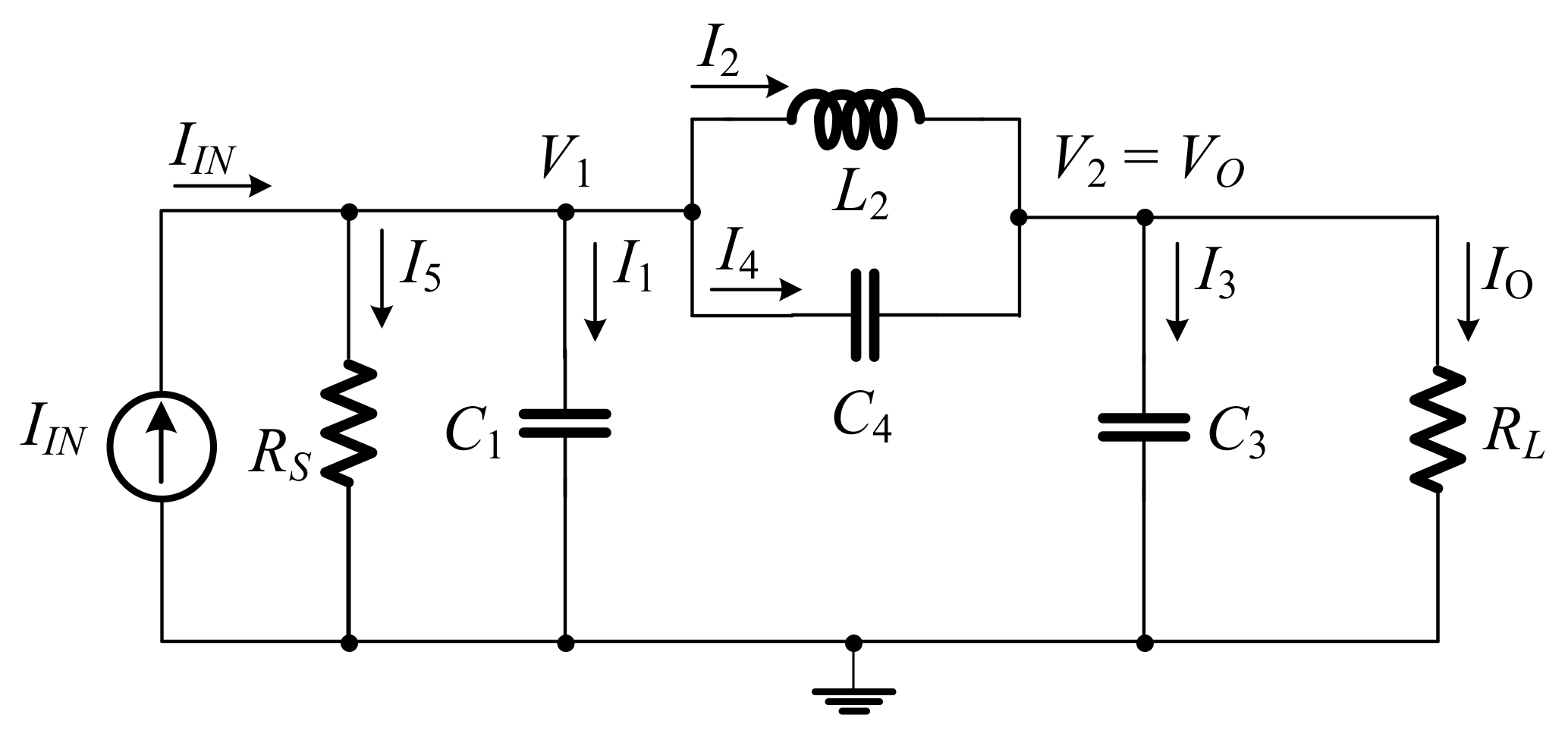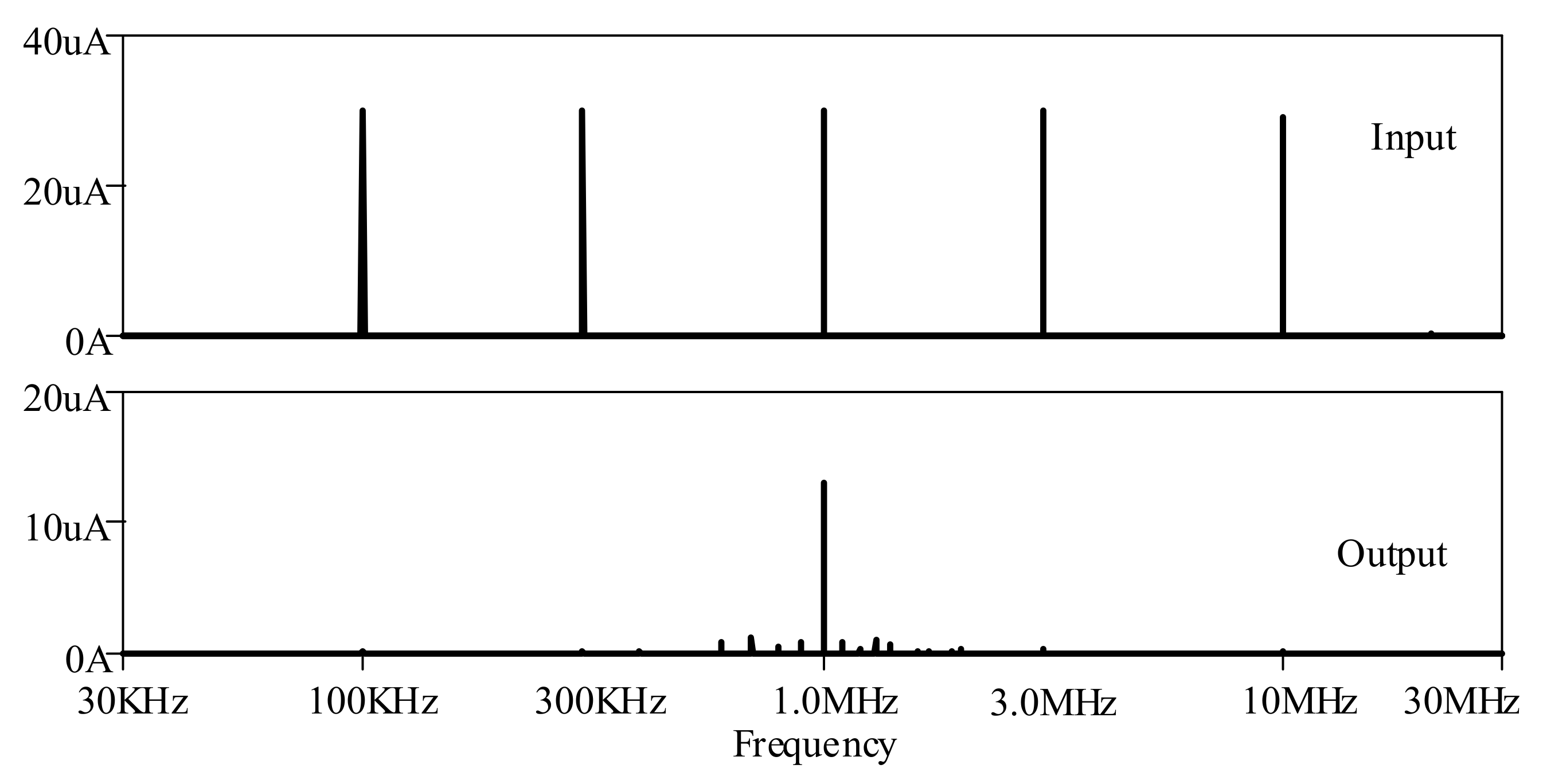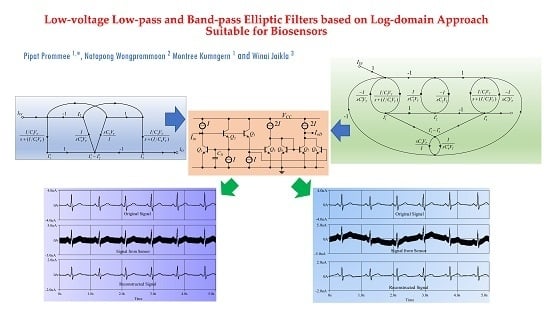1. Introduction
Continuous time filters are essential in electronic sensors and communication devices to remove noise in the circuits. In generic applications, low-order filters are commonplace. First-order filters were used with active devices but were subject to a number of limitations [
1,
2]. Second-order filters could achieve higher performance but are less ideal for electronic sensors and telecommunications applications due to unsatisfactory cut-off frequency [
3].
Further improvements have been made to second-order filters using active building blocks (ABB), such as differential difference amplifier (DDA) [
4], voltage differencing transconductance amplifiers (VDTAs) and variable gain amplifiers (VGA) [
5], and operational transconductance amplifiers (OTAs) and adjustable current amplifiers (ACAs) [
6]. However, they still suffer from limitations inherent in ABBs, including excessive transistors, high-supply voltage, and low-frequency operation.
In telecommunications, the frequency selective property is essential for modulation and demodulation subsystems. High-order low-pass filters (LPF) and band-pass filters (BPF) play an important role in achieving an accurate frequency and rejecting unwanted frequency spectrum. In [
7,
8,
9,
10], higher-order ladder filters were realized using active building blocks, but the filters required floating resistors and capacitors and were less ideal for high frequency operation.
In instrumentation and sensors, very low signals from the sensors, especially in biosensors, are always present and prone to interference [
11]. The noisy signals in an electrocardiogram (ECG) and electromyography (EMG) need to be removed to obtain accurate (noiseless) bio-signals which are essential for diagnosis of patients’ health. Besides, in wearable battery-operated biosensor devices, low-supply voltage is imperative to realize compact biosensors with extended battery life.
In 1979, Adams [
12] developed continuous time filters (i.e., log-domain filters) which were operable at high frequency and required low power consumption. The log-domain filters were further improved to incorporate many complex structures [
13]. In 2008, Psychalinos [
14] proposed the log-domain cells containing a large number of transistors. In [
15,
16], high-performance and low-component-count log-domain cells were incorporated into low-order filters.
In [
17], high-order log-domain Chebyshev filters were realized and deployed as LPF and BPF with tunability features. In addition, high-order log-domain elliptic filters were proposed but the performance was unsatisfactory due to the presence of floating capacitors [
18], accurate current gain requirement [
19], and complicated structure [
20]. Complementary Metal Oxide Semiconductor (CMOS)-based high-order elliptic LPF [
21] and BPF [
22] operable in high frequency were presented, but the accurate current gain requirement posed a significant design challenge.
To overcome the drawbacks inherent in conventional complex high-order elliptic filters, this research proposes simple-structure high-order elliptic LPF and BPF based on log-domain principle. The proposed log-domain elliptic LPF and BPF are realized using differentiators and integrators without accurate current gains and floating passive elements. In addition, the log-domain elliptic LPF and BPF are of wide-range tunability, simple structure, wide dynamic range, and require low power supply.
4. Non-Ideal Analysis
In previous sections, the log-domain cells were analyzed under ideal assumptions. In practice, the cells are influenced by parasitic elements inside bipolar junction transistors (BJT). As a result, the proposed filters are subject to inherent parasitic effects. However, the analysis of parasitic impacts on the filters are highly complicated. The small signal model of BJT is typically used to investigate log-domain cells, as shown in
Figure 16. The BJT small-signal model consists of transconductance
, base-emitter parasitic resistance (
rπ), parasitic conductance of the collector-emitter
, parasitic base-emitter capacitance (
Cπ), and parasitic base-collector capacitance (
Cµ). For ease of investigation, the transconductance (
gm) and parasitic capacitances (
Cπ and
Cµ) of all transistors are assumed to be identical.
4.1. Non-Ideality Effects of Parasitic Resistance (rπ), Conductance (go) and Finite Beta (β)
Finite beta (
β) contributes to gain error in the low frequency range [
12]. Meanwhile, collector-emitter parasitic conductance (
), which is inversely proportional to the early voltage (
VA), and base-emitter parasitic resistance (
) collectively influence the response accuracy of a translinear circuit in the high-frequency range. In
Figure 16, the effects of
rπ and
go on the differentiator transfer function, neglecting the parasitic capacitances (
Cπ and
Cµ), can be expressed in Equations (23) and (24), respectively.
In Equations (23) and (24), the differentiator transfer functions are applicable in the low- to certain high-frequency range. In Equation (23), the differentiator is directly affected by β and functions as a high-gain high-pass filter along the applicable frequency range; and as an LPF at the cut-off frequency. In Equation (24), the differentiator is influenced by conductance (go), as evident in the high-frequency pole at high frequency beyond the operational frequency.
Similarly, the effects of
rπ and
go on the transfer function of the lossless integrator, neglecting parasitic capacitances (
Cπ and
Cµ), can respectively be expressed in Equations (25) and (26).
In Equations (25) and (26), the integrator is directly affected by base-emitter parasitic resistance (rπ) and conductance (go). The integrator functions as an LPF with pole and high gain at low frequency. Indeed, the effect of go on the integrator transfer function is greater than rπ.
For the log-domain lossy integrator, the effect of finite beta (
β) on lossy integrator transfer function and its pole frequency (
Figure 7) can be rewritten as Equations (27) and (28), where
IOLSIn and
Iin denote the specific cases of small signal analysis.
In Equation (28),
β is higher than 100 and has very small impact on the frequency response of lossy integrator. The effect of output conductance (
go) on log-domain lossy integrator can be investigated by the transfer function (Equation (29)) and its pole frequency (Equation (30)).
In Equation (30), the output conductance (go) is generally very small compared to its transconductance (gm) (i.e., go << gm). The output conductance has very small impact on the frequency response of lossy integrator.
4.2. Non-Ideality Effects of Parasitic Capacitance (Cπ and Cµ)
Parasitic capacitances (
Cπ and
Cµ) affect response accuracy and gain error in the high frequency range. Given
Figure 16 and neglecting parasitic resistance (
rπ) and conductance (
go), the effects of
Cπ and
Cµ on the differentiator transfer function can respectively be approximated by Equations (31) and (32).
The parasitic capacitors
Cπ and
Cµ also affect the lossless integrator transfer function, and their respective transfer functions are expressed in Equations (33) and (34).
Similarly,
Cπ and
Cµ also affect the lossy integrator transfer function, and the transfer functions are respectively expressed in Equations (35) and (36).
In Equations (31)–(36), the natural frequencies of the differentiator and both integrators are minimally affected by parasitic capacitances (
Cπ and
Cµ). The natural frequencies of the differentiator and the integrators are in the form of
and
. For the differentiator and the integrators to be operable in high frequency range, either bias current is increased or capacitor value is decreased. For low-power utilization, the bias current must be minimized while the capacitor value is increased. To mitigate natural frequency error, the capacitors
Cd and
Ci should be:
The 2nd- and 3rd-order poles are also included in Equations (31)–(36), which are beyond the operational frequency of the differentiator and the integrators. These high-order poles can, therefore, be neglected.
5. Simulation Results
To verify the performance of the proposed elliptic LP and BP filters, PSpice simulation was carried out. To minimize errors as per the nonideal analysis, the capacitors in the circuits should be 50 pF or higher. The supply voltage was as low as 1.5 V (2
VBEon +
Vcomp), which was adequate for compressed voltage swing (
Vcomp) around 0.3 V. The HFA3127 transistor array was used in the simulation [
15].
The proposed lossless differentiator was simulated by varying
IB between 1 µA, 10 µA, 100 µA, and 1000 µA with C = 50 pF, as shown in
Figure 17. The magnitude responses varied in response to varying
IB. The differentiator is directly affected by finite
β as low-pass function at high-frequency which explained in equation (23). Note that the effect of finite
β is far from the operating frequency of differentiator.
Figure 18 shows the magnitude response of the lossless integrator under variable
IB (i.e., 1 µA, 10 µA, 100 µA, and 1000 µA) with C = 50 pF.
Figure 19 illustrates the magnitude response of the lossy integrator or first-order LPF under varying
IB (1 µA, 10 µA, 100 µA, and 1000 µA) with C = 50 pF. The simulation results of the differentiator and integrators are in good agreement with theory.
Figure 20 compares between the magnitude responses of the proposed log-domain elliptic ladder LPF and the RLC LPF prototype, given 1 MHz cut-off frequency. In order to achieve the same magnitude response at 1 MHz,
C1 =
C3 = 790 pF,
= 860 pF,
C4 = 50 pF, and
IB = 105 µA for the proposed elliptic LPF (
Figure 12); and
RS =
RL = 1Ω,
C1 =
C3 = 158 nF,
L2 = 172 nH, and
C4 = 9 nF for the RLC LPF prototype (
Figure 1). The magnitude responses are of similar shape despite small differences in pass band ripple and stopband attenuation.
Figure 21 shows the magnitude responses of the high-order elliptic ladder LPF under varying
IB (i.e., 1 µA, 10 µA, 100 µA, and 1000 µA), given
C1 =
C3 = 790 pF,
= 860 pF,
C4 = 50 pF (
Figure 12). This simplified the proposed elliptic LPF structure, compared with [
21] which required two substantially diverse current gains. The accuracy performance of the proposed LPF is more agreeable with theory, in comparison with the conventional complex high-order elliptic LPF.
Multi-tone testing was carried out with the proposed elliptic ladder LPF by biasing input between 100 kHz, 300 kHz, 1 MHz, 3 MHz, 10 MHz, and 30 MHz, given
IB of 120 μA for 1MHz passband.
Figure 22 depicts the frequency spectra of input and output of the elliptic ladder LPF. The LPF output was 1 MHz and below, while the rest with higher frequencies were completely filtered out.
Furthermore, an ECG signal (biosensor signal) was applied to the proposed high-order LPF with certain reconfigurations. Given
C1 =
C3 = 790 nF,
= 860 nF,
C4 = 50 nF with bias current
I = 5 μA, the frequency response is obtained around 60Hz (
Figure 23), with a very small noise output of around 128 pV along the frequency of 1 Hz–1 kHz (
Figure 24). In
Figure 25, the original ECG signal with high-frequency (random) noises is applied to the proposed LPF filter, and the reconstructed ECG signal is realized without noise as the noise signals at high frequency are removed.
Figure 26 compares the magnitude response of the proposed log-domain elliptic ladder BPF with that of RLC ladder prototype, given 1 MHz cut-off frequency. To achieve the same frequency response at 1 MHz,
C1 =
=
C2 =
=
C 3 =
= 500 pF,
= 5 nF,
C4 = 50 pF, and
IB = 105 µA for the proposed high-order elliptic ladder BPF (
Figure 15); and
RS =
RL = 1Ω,
C1 =
C2 =
C3 = 120 nF,
L1 =
L2 =
L3 = 120 nH,
C4 = 12 nF, and
L4 = 1.2 µH for the RLC ladder prototype (
Figure 3). The magnitude responses are of similar shape with very small differences in pass band ripple and stopband attenuation.
Figure 27 shows the magnitude responses of the proposed high-order elliptic ladder BPF under varying
IB (1 µA, 10 µA, 100 µA and 1000 µA), given
C1 =
=
C2 =
=
C3 =
= 500 pF,
= 5 nF,
C4 = 50 pF (
Figure 15). This simplified the proposed elliptic BPF structure, compared with [
22] which required two substantially diverse current gains. The accuracy performance of the proposed BPF is more agreeable with theory than the conventional elliptic BPF.
Multi-tone testing was carried out with the proposed elliptic ladder BPF by biasing input between 100 kHz, 300 kHz, 1 MHz, 3 MHz, 10 MHz, and 30 MHz, given
IB of 80 μA for 1 MHz center frequency.
Figure 28 depicts the frequency spectra of input and output of the proposed BP filter. The BPF output was 1 MHz while other frequencies were filtered out.
Besides, an ECG signal was applied to the proposed high-order BPF with certain reconfigurations. Given
C1 =
C3 =
= 500 nF,
=
C2 =
= 20 μF,
C4 = 50 nF and
= 200 μF with bias current
I = 3 μA, the lower and higher cut-off frequencies are, respectively, obtained around 0.6 Hz and 60 Hz, as shown in
Figure 29, with a very small noise output of around 128 pV along the frequency of 0.1 Hz–10 kHz (
Figure 30). In
Figure 31, the original ECG signal with low- and high-frequency (random) noises is applied to the proposed BPF filter, and the reconstructed noiseless ECG signal is achievable as the low- and high-frequency noises in the stop-band of the proposed BPF are completely removed.















































